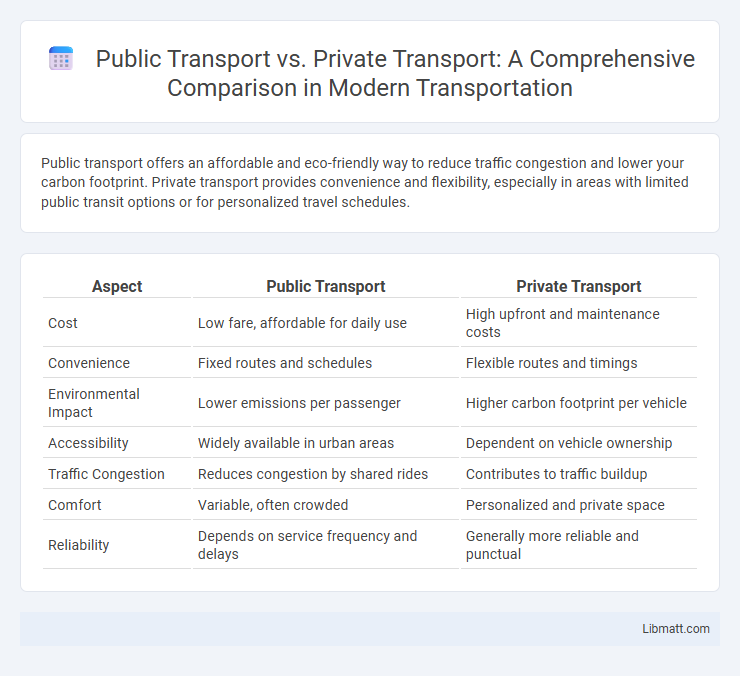Public transport offers an affordable and eco-friendly way to reduce traffic congestion and lower your carbon footprint. Private transport provides convenience and flexibility, especially in areas with limited public transit options or for personalized travel schedules.
Table of Comparison
| Aspect | Public Transport | Private Transport |
|---|---|---|
| Cost | Low fare, affordable for daily use | High upfront and maintenance costs |
| Convenience | Fixed routes and schedules | Flexible routes and timings |
| Environmental Impact | Lower emissions per passenger | Higher carbon footprint per vehicle |
| Accessibility | Widely available in urban areas | Dependent on vehicle ownership |
| Traffic Congestion | Reduces congestion by shared rides | Contributes to traffic buildup |
| Comfort | Variable, often crowded | Personalized and private space |
| Reliability | Depends on service frequency and delays | Generally more reliable and punctual |
Introduction to Public vs Private Transport
Public transport includes buses, trains, and subways serving multiple passengers on fixed routes, offering affordable and eco-friendly mobility options in urban areas. Private transport comprises personal vehicles like cars and motorcycles, providing flexibility, convenience, and direct point-to-point travel but often contributing to traffic congestion and higher emissions. Comparing the two modes highlights trade-offs between cost efficiency, environmental impact, and user independence in daily commuting.
Environmental Impact of Transport Choices
Public transport significantly reduces carbon emissions by carrying multiple passengers simultaneously, lowering per capita greenhouse gas output compared to private vehicles. Private transport contributes to higher air pollution and increased fossil fuel consumption due to single-occupancy trips and less efficient fuel use. Choosing buses, trains, and trams supports sustainability goals by decreasing overall transportation-related environmental footprints.
Cost Comparison: Public and Private Transport
Public transport generally offers a more cost-effective solution compared to private transport, with average monthly expenses for buses or trains often being significantly lower than the combined costs of fuel, maintenance, insurance, and parking for private vehicles. According to studies, the annual cost of owning and operating a private car can exceed $9,000, whereas public transit expenses average around $1,200 to $1,500 per year in many urban areas. These financial differences highlight public transport's potential to reduce individual commuting costs and overall environmental impact.
Convenience and Accessibility Factors
Public transport offers extensive coverage and scheduled services that make commuting convenient for many urban and suburban areas, often reducing the need for parking and navigation concerns. Private transport provides personalized routes and flexible timing, enhancing convenience for those with irregular schedules or destinations not served by public systems. Your choice depends on how accessibility, travel flexibility, and time constraints align with your daily needs and lifestyle.
Time Efficiency: Which is Faster?
Public transport often benefits from dedicated lanes and priority signaling, reducing travel time during peak hours compared to private vehicles stuck in traffic congestion. Conversely, private transport offers direct routes without stops, providing faster door-to-door travel in less crowded urban settings. Time efficiency depends largely on city infrastructure, with public transit excelling in densely populated areas and private vehicles preferred in suburban or rural regions.
Comfort and Privacy in Transportation
Private transport offers superior comfort and privacy, allowing passengers to control their environment, avoid crowds, and enjoy personalized seating. Public transport often involves shared spaces and fixed schedules, which can limit comfort and reduce privacy due to higher passenger density. Advances in public transportation design aim to improve comfort, but private vehicles still provide unmatched personal space and convenience.
Urban Congestion and Traffic Solutions
Urban congestion intensifies as private transport vehicles dominate city streets, leading to longer travel times and increased pollution. Public transport systems, including buses, subways, and trams, provide efficient traffic solutions by reducing the number of cars and optimizing road space. Investing in reliable, high-capacity public transit networks enhances mobility and mitigates traffic congestion in densely populated urban areas.
Safety and Security Considerations
Public transport systems implement rigorous safety protocols, including surveillance cameras, emergency communication systems, and routine staff training, reducing risks for passengers. Conversely, private transport exposes individuals to higher accident rates due to factors like driver error and less regulated vehicle maintenance. Security concerns in public transport are mitigated by centralized monitoring and rapid response teams, whereas private vehicle users rely primarily on personal safety measures.
Social and Community Impacts
Public transport fosters social inclusion by providing affordable mobility options that connect diverse communities, reducing isolation for low-income and elderly populations. It encourages environmental sustainability and collective responsibility by minimizing traffic congestion and lowering carbon emissions compared to widespread private vehicle use. Community well-being improves through enhanced accessibility to jobs, education, and healthcare services, strengthening economic opportunities and social cohesion.
Future Trends in Urban Mobility
Future trends in urban mobility emphasize the integration of public transport with digital technologies like real-time tracking, contactless payment systems, and autonomous vehicles, enhancing efficiency and user experience. Private transport is evolving with electric and shared mobility options, reducing environmental impact and urban congestion. Embracing these innovations will transform your daily commute, promoting sustainability and smarter city living.
public transport vs private transport Infographic

 libmatt.com
libmatt.com